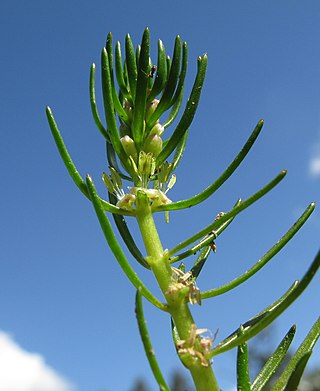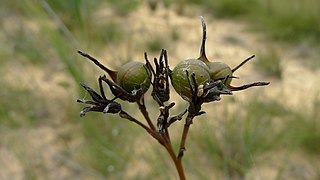
Hymenosporum is a monotypic genus in the family Pittosporaceae. The sole included species is Hymenosporum flavum, commonly known as native frangipani, which is a rainforest tree native to New Guinea, Queensland and New South Wales. Despite its common name, it is not closely related to the frangipani, but is related to the widespread genus Pittosporum.

Dianella tasmanica, commonly known as the Tasman flax-lily or Tasmanian flax-lily is a herbaceous strappy perennial herb of the family Asphodelaceae, subfamily Hemerocallidoideae, found in southeastern Australia including Tasmania. It has leaves to 80 cm, and a flower stem to 1.5 m. Blue flowers in spring and summer are followed by violet berries. It adapts readily to cultivation and is commonly seen in Australian gardens. Unlike other Dianella species, its fruit is toxic.

Forstera bellidifolia, the Tasmanian forstera, is a species in the family Stylidiaceae that is endemic to Tasmania, Australia. It was described by William Jackson Hooker in an 1851 volume of Icones Plantarum. It is notably different from other members of the genus in that it is not native to New Zealand nor does it possess the epigynous nectaries that are present in the other species.

Velleia montana, commonly known as mountain velleia, is a flowering plant in the family Goodeniaceae. It is a small, perennial herb with tubular yellow flowers, mainly growing in woodland and sub-alpine grasslands in New South Wales, Victoria and Tasmania.

Geranium potentilloides, belongs to the family Geraniaceae, and is a small prostrate perennial herb that can grow up to 60cm high. The species is commonly referred to as Soft Cranesbill or Cinquefoil geranium.

Scaevola hookeri, commonly known as the creeping fan-flower or alpine fan-flower, is a species of flowering plant in the family Goodeniaceae. It has white or blue flowers with a yellow throat and grows in eastern Australia.

Gymnoschoenus sphaerocephalus, commonly known as buttongrass, is a species of tussock-forming sedge from southeastern Australia. It forms part of a unique habitat in Tasmania.

Muehlenbeckia axillaris is a low evergreen shrub, forming wiry mats up to about 1 metre in diameter, native to New Zealand, and the Australian states of Tasmania, New South Wales and Victoria. It has thin, red-brown stems, with glossy squarish to roundish leaves that are less than 1 cm (0.39 in) in diameter and 2–4 mm (0.079–0.157 in) thick. Flowers are inconspicuous, yellowish-white, 4–8 mm (0.16–0.31 in) in diameter, and borne in groups of up to three in the axils. The fruit is black, shiny, and up to 3.5 mm (0.14 in) long, produced in late summer to fall.

Leptospermum rupestre, commonly known as alpine tea-tree or prostrate tea-tree, is a flowering shrub in the myrtle family, Myrtaceae. It is endemic to Tasmania. In alpine areas it assumes a prostrate habit while in subalpine areas it appears as a large shrub.

Haemodorum is a genus of herbs in the family Haemodoraceae, first described as a genus in 1798 by James Edward Smiith. The genus is native to New Guinea and Australia. The type species is Haemodorum corymbosum Vahl, first described by Martin Vahl in 1805.

Myriophyllum variifolium is a species of water milfoil native to eastern Australia where it grows in aquatic habitat such as ponds and streams.

Haemodorum corymbosum, commonly known as the rush-leaf bloodroot, is a shrub native to southeastern Australia. Danish-Norwegian naturalist Martin Vahl described this species in his 1805 work Enumeratio Plantarum.

Haemodorum brevicaule is a perennial herb from 0.025 to 0.3 m tall, in the bloodroot family, the Haemodoraceae, native to northern Australia. It has deep-red to purplish-black flowers which are seen from September to December, and it grows on red clay and basalt.

Haemodorum spicatum is a plant in the Haemodoraceae family native to south Western Australia.

Cyanothamnus nanus, commonly known as the dwarf boronia or small boronia is a plant in the citrus family Rutaceae and is endemic to eastern Australia. It is a prostrate or low spreading shrub with simple or three-part leaves and white or pale pink four-petalled flowers.

Brachyscome decipiens, commonly known as field daisy, is a perennial herb in the family Asteraceae and is endemic to Australia. It is a small herb with white or pale blue flowers.

Stenanthemum pimeleoides, commonly known as spreading stenanthemum or propellor plant, is a species of flowering plant in the family Rhamnaceae and is endemic to Tasmania. It is a small, prostrate, mat-forming shrub with hairy young stems, egg-shaped leaves with the narrower end towards the base, and densely hairy clusters of tube-shaped flowers surrounded by conspicuous, whitish floral leaves.

Haemodorum laxum is a plant in the Haemodoraceae family, native to Western Australia, and was first described by Robert Brown in 1810.

Haemodorum simplex is a plant in the Haemodoraceae family, native to the south west of Western Australia, and was first described by John Lindley in 1840.




















